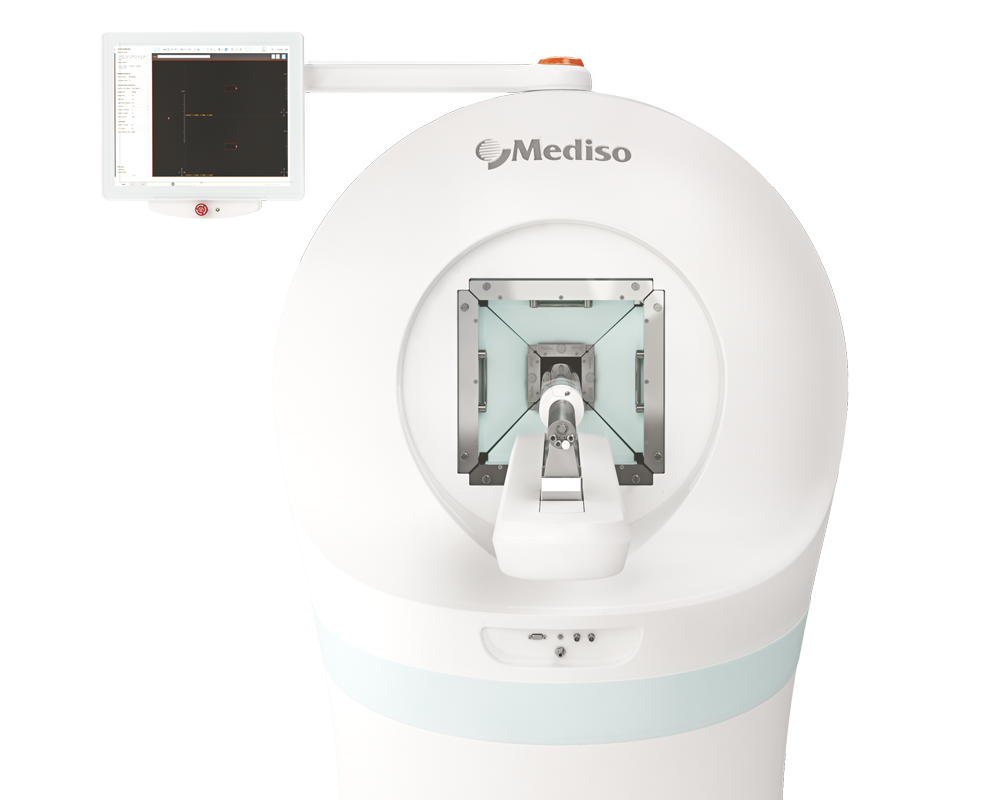Reduction of Negative Charge in Mercaptoacetyl-Based Chelators Influences the Biodistribution of Prostate-Specific Membrane Antigen-Targeting Pseudopeptides Labeled with Technetium-99m
2025.09.25.
Ekaterina Bezverkhniaia et al., ACS Pharmacology & Translational Science, 2025
Summary
Prostate cancer (PCa) is the most common cancer and the second leading cause of death among men worldwide. Over the past decade, there have been dramatic improvements in the detection and staging of PCa with the widespread introduction of prostate-specific membrane antigen (PSMA) targeting agents based on the glutamate–urea–lysine (EuK) binding moiety in clinical practice. The majority of the PSMA-targeting tracers were developed for positron emission tomography (PET) but the limited global availability of these cameras brings challenges in the efficient implementation of PSMA imaging. The recent advancements in the development of new-generation single-photon emission tomography (SPECT) cameras, the low cost of SPECT investigations, and the high prevalence of PCa, with the projected increase of diagnosed cases, support the development of PSMA imaging agents for SPECT imaging.
Previously, a high-affinity EuK-based PSMA-targeting tracer, BQ0413 was reported by the authors, containing the maE3 chelator for labeling with technetium-99m for SPECT diagnostic imaging. BQ0413 demonstrated efficient tumor targeting in PCa patients with concomitant elevated activity retention in the kidneys, which is typical for EuK-based PSMA-targeting tracers. It was hypothesized that a decrease in the tracer’s total negative charge, by substituting negatively charged glutamate residues in the maE3 chelator with polar neutral serine, could decrease activity retention in the kidneys. The present study aimed to evaluate the tumor targeting and biodistribution profile of two new PSMA-targeting tracers, BQ0500 (maESE) and BQ0501 (maS3), in comparison with BQ0413 (maE3). Conjugates were successfully radiolabeled with technetium-99m and characterized in vitro and in vivo. [99mTc]Tc-BQ0500 and [99mTc]Tc-BQ0501 demonstrated PSMA-specific binding to PC3-pip cells with picomolar affinity; however, the affinity was 3–5-fold compromised in comparison with the reference [99mTc]Tc-BQ0413. Full replacement of glutamate residues by serines in [99mTc]Tc-BQ0501 resulted in an improved overall clearance from normal organs with a moderately increased accumulation of activity in the gastrointestinal tract. [99mTc]Tc-BQ0501 demonstrated efficient tumor targeting and improved tumor-to-background ratios. These results suggest that chelator modifications, such as charge alteration, play a critical role in improving tumor targeting and pharmacokinetics for EuK-based PSMA-targeting tracers.
Results from nanoScan® SPECT/CT
For SPECT/CT imaging, the mice were intravenously injected with 5 nmol (1 MBq) of [99mTc]Tc-BQ0413, [99mTc]Tc-BQ0500, and [99mTc]Tc-BQ0501. Whole-body scans were performed for 3 h using nanoScan® SPECT/CT (Mediso Medical Imaging Systems Ltd., Budapest, Hungary). SPECT raw data were reconstructed using Tera-Tomo™ 3D SPECT reconstruction technology (version 3.00.020.000; Mediso Medical Imaging Systems Ltd., Budapest, Hungary): normal dynamic range; 30 iterations; and one subset. CT data were reconstructed using Filtered Back Projection in Nucline 2.03 Software (Mediso Medical Imaging Systems Ltd., Budapest, Hungary). SPECT and CT files were fused using Nucline 2.03 Software and are presented as maximum intensity projections on the RGB color scale visualized using InterView™ FUSION (Mediso Medical Imaging Systems Ltd., Budapest, Hungary).
Results show:
Images acquired by the nanoScan® SPECT/CT indicated clear detection of the PSMA-expressing tumors and confirmed the results from ex vivo biodistribution.
- PSMA-expressing tumors are clearly noticeable for all three conjugates at 3 h pi. Kidney uptake and renal excretion were observed for [99mTc]Tc-BQ0413 and [99mTc]Tc-BQ0500. For [99mTc]Tc-BQ0501, besides accumulation in the tumor, activity in the gastrointestinal tract was visualized (see figure 7). Uptake in other tissues was much lower compared to the tumor uptake.

Figure 7. Representative nanoScan SPECT/CT images of PC3-pip xenografted mice injected with 5 nmol (1 MBq) [99mTc]Tc-BQ0413 (A), [99mTc]Tc-BQ0500 (B), and [99mTc]Tc-BQ0501 (C) at 3 h pi. The linear scale was adjusted to the first red pixel in the tumor. White arrows point to tumors (T).
- The imaging supports that the PSMA-targeting pseudopeptides remain sufficient in tumor uptake even when the chelator charge is reduced; the contrast in the SPECT/CT images indicates that tumor uptake remains appreciable compared to background.
- Overall the changes in the chelator’s negative charge lead to measurable differences in tracer localization, clearance, and off-target uptake.
- The performance of [99mTc]Tc-BQ0500 and [99mTc]Tc-BQ0501 compared to the previously reported technetium-99m-labeled PSMA-targeting tracers indicated that the presented compounds exhibit comparable or superior PSMA binding affinity.
The authors highlight that optimal clearance pattern permits detection of abdominal metastases, a reduction of activity in the gastrointestinal tract is crucial to further improve the imaging properties of [99mTc]Tc-BQ0501 as a promising probe for SPECT diagnostic imaging in PCa patients.
Conclusion
Two novel EuK-based PSMA-targeting tracers were developed, [99mTc]Tc-BQ0500 and [99mTc]Tc-BQ0501, for visualization of PCa using SPECT, both with picomolar affinity to PSMA. These newly developed tracers were evaluated in vitro and in vivo in comparison with the previously developed tracer [99mTc]Tc-BQ0413. The present study demonstrates that a modification of the chelator (that does not participate in PSMA-binding) plays a critical role in the tumor targeting and pharmacokinetic properties for EuK-based tracers. Specifically, replacement of the maE3 chelator by the maS3 chelator reduced renal activity retention and improved tumor-to-background ratios while moderately increasing abdominal activity uptake.
Full article on ACSPublications
Hogyan segíthetünk Önnek?
További termékinformációkért, vagy támogatásért keresse szakértőinket!
Vegye fel a kapcsolatot
